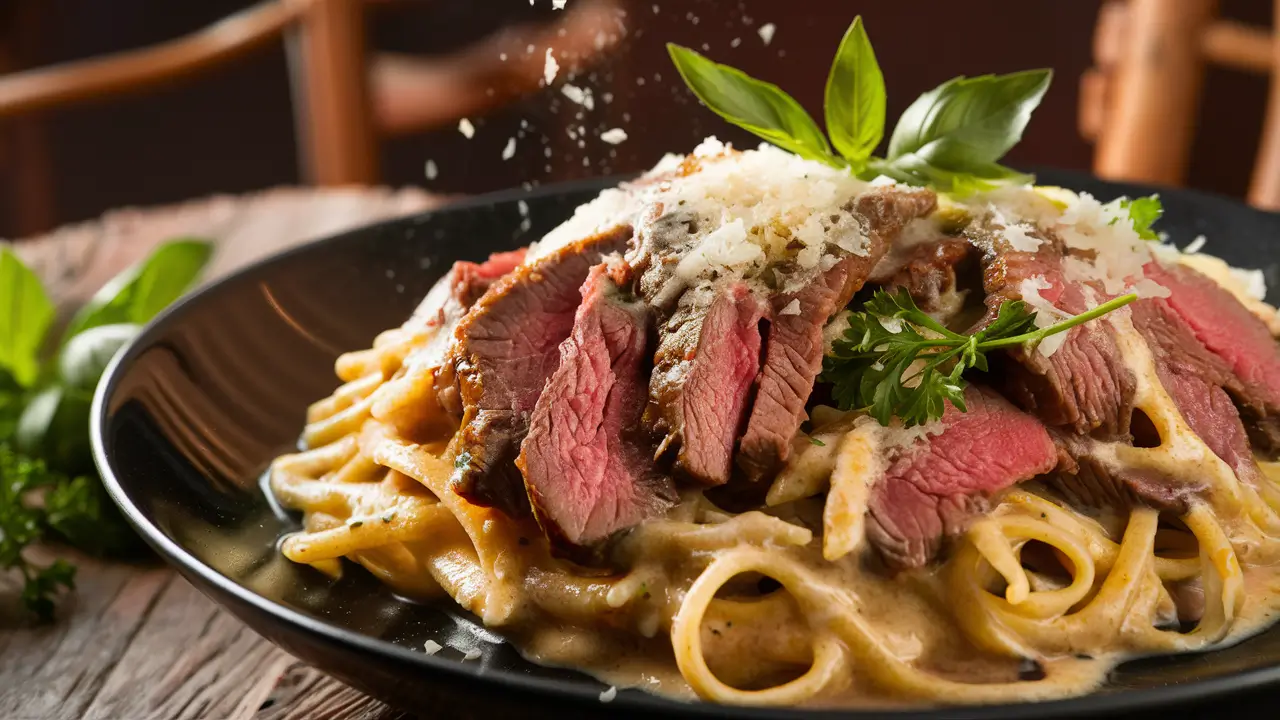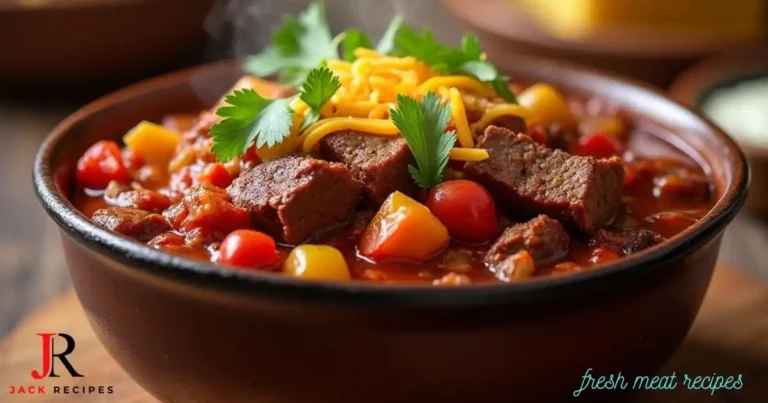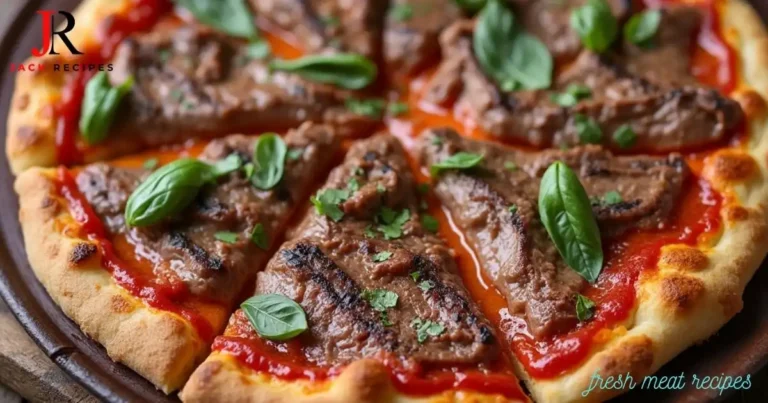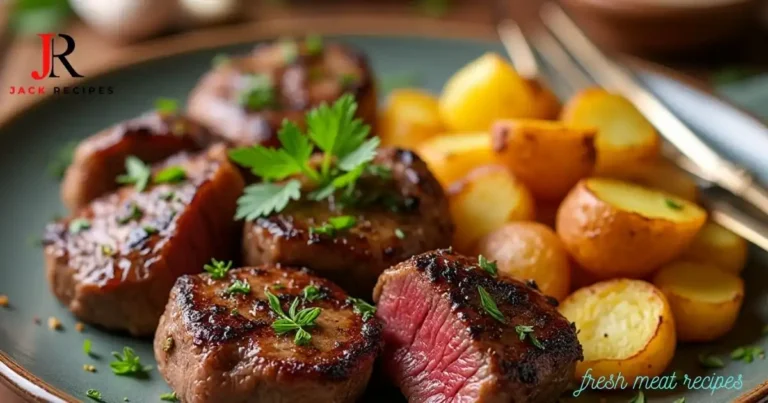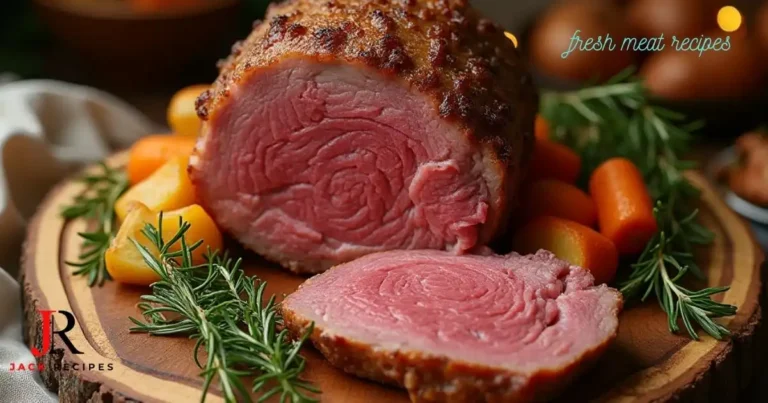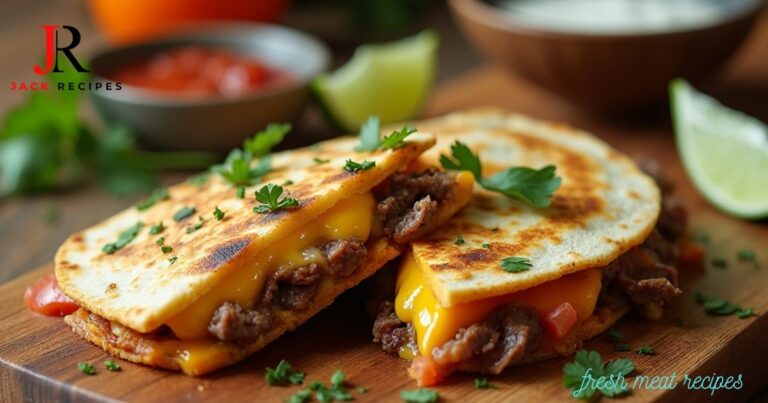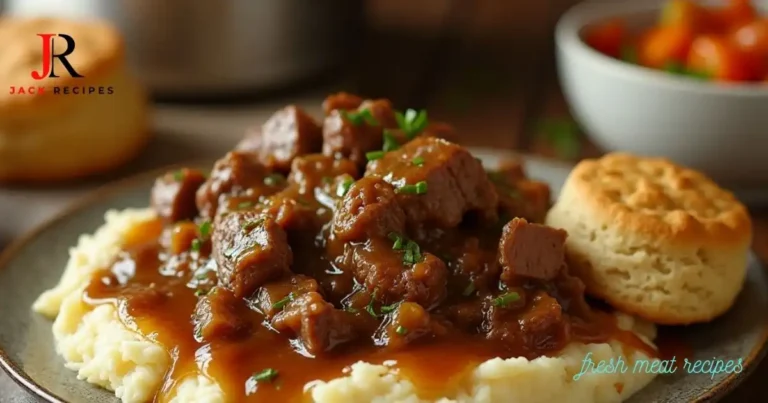Easy Steak Pasta Recipe 2025 – The Best Creamy Delight
Why You’ll Love This Recipe
When it comes to a hearty and satisfying meal, steak pasta checks all the right boxes. This dish is not just another pasta recipe—it’s a perfect blend of tender, juicy steak with a rich, creamy sauce that clings to every bite of perfectly cooked pasta. Whether you’re making it for a special occasion or a busy weeknight, this dish offers a restaurant-quality experience right in your kitchen. Let’s dive into why this recipe will become your go-to favorite.
Rich, Creamy, and Packed with Flavor
One of the biggest reasons people fall in love with this steak pasta is its indulgent texture and deep flavor. Here’s what makes it so irresistibly delicious:
- Perfectly Seared Steak – Cooking the steak just right ensures a juicy, flavorful bite in every forkful. Whether you prefer medium-rare or well-done, proper seasoning and searing technique enhance the natural beefy goodness.
- Velvety Cream Sauce – A luxurious blend of heavy cream, butter, parmesan cheese, and garlic creates a silky, rich sauce that elevates the dish beyond basic pasta recipes.
- Flavor Depth with Herbs & Spices – A balance of fresh garlic, black pepper, and a touch of Italian herbs infuses the dish with an aromatic warmth that complements the steak beautifully.

Quick and Easy to Prepare
This steak pasta recipe is designed for busy food lovers who want a gourmet experience without spending hours in the kitchen. You don’t need professional chef skills—just simple techniques to get amazing results every time.
- Minimal Prep Time: This recipe requires less than 10 minutes of prep, making it an excellent choice for last-minute meals.
- One-Pan Cooking Method: Cook the steak, pasta, and sauce in the same pan to reduce cleanup time while maximizing flavor.
- 15-Minute Cooking Time: From pan to plate, this entire dish is ready in under 30 minutes!

Perfect for Weeknights or Special Occasions
Whether you’re making a quick family dinner or planning a romantic date night meal, steak pasta fits the occasion effortlessly.
- Weeknight Favorite: This dish is hearty yet simple, making it ideal for a fast, comforting meal that doesn’t compromise on taste.
- Great for Entertaining: Impress guests with restaurant-quality steak pasta without spending hours in the kitchen. Serve it with garlic bread and a glass of wine for the ultimate dining experience.
- Customizable for Any Occasion: Adjust the steak cut, pasta type, or add-ins (like mushrooms or spinach) to match the vibe of any meal.

What You Need for Steak Pasta
Creating the perfect steak pasta starts with selecting the right ingredients and equipment. From choosing the best pasta type and steak cut to crafting a luxurious creamy sauce, every component plays a crucial role in the final dish. Below, we break down everything you need to make this dish flavorful, creamy, and restaurant-worthy.
A.Key Ingredients
1. Pasta Choices
The pasta you choose significantly affects the texture and how well the sauce clings to it. Here are the best pasta types for steak pasta:
- Fettuccine – Its wide, flat shape holds creamy sauces beautifully.
- Tagliatelle – Slightly thicker than fettuccine, perfect for rich, meaty dishes.
- Pappardelle – Best for those who love extra-wide noodles for a more luxurious bite.
- Penne or Rigatoni – Great for holding chunks of steak and thick sauce in every bite.

2. Steak Selection
The star of the dish is undoubtedly the steak. Choosing the right cut ensures a juicy, flavorful bite in every forkful.
What Kind of Steak Should You Use?
- Ribeye – Rich in marbling, making it juicy and flavorful.
- Sirloin – A leaner option but still tender and delicious.
- Filet Mignon – The most tender, perfect for a melt-in-your-mouth experience.
- New York Strip – A balance of tenderness and beefy flavor.
Best Way to Cook Steak for Pasta
To get restaurant-quality steak:
- Season generously with salt, pepper, and garlic powder.
- Sear on high heat in a cast-iron pan for a crispy crust.
- Rest the steak before slicing to lock in the juices.

3. Creamy Sauce Essentials
A rich, velvety sauce is what brings this steak pasta together.
Do You Need to Make Your Own Sauce?
Yes! While store-bought sauces can work in a pinch, a homemade creamy garlic parmesan sauce takes this dish to the next level. The key ingredients include:
- Heavy cream – For a thick, luxurious texture.
- Butter – Enhances the richness.
- Garlic – Freshly minced for an aromatic boost.
- Parmesan cheese – Adds nutty, umami depth.

4. Additional Toppings and Flavor Boosters
To elevate your steak pasta, consider these bonus flavor ideas:
- Mushrooms – Adds earthy depth.
- Spinach or Kale – For a fresh, slightly bitter contrast.
- Sun-dried Tomatoes – Intensifies the umami and sweetness.
- Crushed Red Pepper – A little heat makes the dish exciting.
- Truffle Oil – A drizzle at the end adds gourmet flair.
B. Equipment Needed
To make steak pasta like a pro, you’ll need:
- Cast-Iron Skillet or Heavy Pan – Essential for getting a perfect sear on the steak.
- Large Pot – For boiling pasta without sticking.
- Sharp Chef’s Knife – To slice the steak cleanly.
- Wooden Spoon – Ideal for stirring the sauce without scratching the pan.
- Tongs – Makes flipping and handling the steak easier.
Step-by-Step: How to Make Steak Pasta
Now that you have the best ingredients and equipment, it’s time to bring everything together. Follow this step-by-step guide to make a restaurant-quality steak pasta at home.
A. Cooking the Pasta
Getting the perfect pasta texture is essential for a great dish. Follow these pro tips:
- Use plenty of water – A large pot ensures the pasta cooks evenly without sticking.
- Salt the water generously – This enhances the flavor from the inside.
- Cook until al dente – The pasta should be firm but tender (check package instructions).
- Reserve pasta water – A cup of this starchy water helps thicken the sauce later.
- Drain but don’t rinse – Rinsing removes the starch that helps the sauce cling to the pasta.

B. Preparing the Steak
A perfectly cooked juicy steak is the heart of this dish. Use these best techniques to get a mouthwatering result:
1. Seasoning the Steak
- Pat the steak dry with paper towels.
- Season generously with salt, black pepper, and garlic powder.
- Let it sit for 10-15 minutes to absorb the flavors.
2. Cooking for the Best Texture
- Heat a cast-iron skillet over high heat.
- Add butter and a drizzle of oil to prevent burning.
- Sear the steak for 3-4 minutes per side for a perfect medium-rare.
- Let it rest for 5 minutes before slicing—this locks in the juices.

C. Making the Cream Sauce
This rich, velvety sauce ties everything together. Here’s how to make the best creamy garlic parmesan sauce:
- Melt butter in a pan over medium heat.
- Add minced garlic and cook until fragrant.
- Pour in heavy cream and let it simmer.
- Stir in parmesan cheese, letting it melt completely.
- Season with salt, pepper, and a pinch of nutmeg for depth.
- If needed, add reserved pasta water to adjust consistency.

D. Combining Everything
Now for the best part—bringing everything together for a flavor-packed dish:
- Add cooked pasta to the creamy sauce, tossing gently.
- Stir in sliced steak, allowing the flavors to blend.
- Finish with a sprinkle of parmesan, fresh parsley, and chili flakes.
- Serve immediately for the best taste and texture.

Tips for the Best Result
Creating the perfect steak pasta isn’t just about following a recipe—it’s about mastering the small details that elevate your dish from good to restaurant-quality. Here are pro tips to help you achieve the best results every time.
A. Common Mistakes to Avoid
Even experienced cooks can make small mistakes that affect the flavor, texture, and overall presentation of steak pasta. Avoid these pitfalls:
1. Overcooking the Steak
- Cooking the steak too long makes it dry and tough.
- Aim for medium-rare to medium (130-140°F/54-60°C).
- Always rest the steak before slicing to keep it juicy.
2. Undercooking or Overcooking the Pasta
- Cooking past al dente results in mushy pasta.
- Undercooked pasta won’t absorb the sauce properly.
- Use a timer and taste-test for the perfect texture.
3. Using a Cold Pan for the Steak
- A hot skillet creates the best sear and locks in flavor.
- Always preheat your pan for 2-3 minutes before adding steak.
4. Adding Cold Ingredients to the Sauce
- Adding cold cream or cheese can make the sauce grainy.
- Let dairy ingredients come to room temperature before using.
5. Skipping the Reserved Pasta Water
- The starchy pasta water helps the sauce cling to the noodles.
- Add a few tablespoons at a time for the perfect creamy consistency.

B. How to Enhance Flavors
Take your steak pasta to the next level with these expert flavor-boosting tips:
1. Use Fresh, High-Quality Ingredients
- Opt for grass-fed beef for a richer, beefier taste.
- Fresh garlic, parmesan, and heavy cream make a huge difference in sauce quality.
2. Layer Your Seasonings
- Season in stages—season the steak, the pasta water, and the sauce separately.
- Finish with a touch of flaky sea salt to enhance all flavors.
3. Add Depth with Aromatics
- Sautéed shallots or caramelized onions give an umami kick.
- A splash of white wine or Worcestershire sauce enhances the steak’s richness.
4. Boost Creaminess Without Overpowering
- Too much cream can make the sauce heavy—balance it with a touch of lemon zest or Dijon mustard.
- A small amount of butter at the end gives the sauce a luxurious finish.
5. Garnish Like a Pro
- Fresh herbs like parsley or basil add brightness.
- Shaved parmesan and a drizzle of olive oil give a gourmet touch.
- A pinch of red pepper flakes for subtle heat.

Serving and Enjoying Your Steak Pasta
Now that you’ve prepared your perfect steak pasta, it’s time to serve it up in style! The right side dishes and pairings can elevate your meal even further. Here’s how to make your steak pasta experience unforgettable.
A. Serving Suggestions
1. Fresh and Crisp Salad
- A green salad with a tangy vinaigrette complements the rich, creamy flavors of the steak pasta.
- Try a caesar salad or a Mediterranean mix with tomatoes, olives, and feta for a burst of freshness.
- If you’re in the mood for something light, a simple arugula salad dressed with lemon juice and olive oil works wonders.
2. Garlic Bread or Crusty Loaf
- Pair your steak pasta with crispy garlic bread or a rustic baguette for dipping in the creamy sauce.
- The garlic butter flavors will perfectly complement the richness of your pasta dish.
3. Roasted Vegetables
- Roasted asparagus, broccoli, or baby carrots provide a nice, healthy contrast to the creamy pasta.
- Roasted Brussels sprouts or zucchini add both texture and flavor, making your plate more dynamic.
4. Light White Wine or Sparkling Water
- A crisp white wine like Sauvignon Blanc or Chardonnay pairs perfectly with steak pasta.
- If you prefer non-alcoholic options, try a sparkling water with a lemon wedge or a herbal iced tea.

B. Delicious Steak Recipes to Try
Expand your steak pasta experience by exploring more ways to enjoy steak in different dishes. These flavorful steak recipes will keep you coming back for more!
1. Steak and Potatoes
- Classic and hearty, steak and potatoes is a foolproof dinner combination.
- Try a ribeye or sirloin steak with garlic mashed potatoes or crispy roasted potatoes.
2. Steak Fajitas
- Juicy steak strips cooked with peppers and onions, served with warm tortillas, make for a fantastic Mexican-inspired meal.
- Add a dollop of guacamole and sour cream for extra creaminess.
3. Steak Salad
- A grilled steak salad combines tender slices of steak with fresh greens and a zesty dressing.
- Try topping with blue cheese or crumbled goat cheese for an added flavor boost.
4. Grilled Steak Sandwich
- Perfect for lunch, a grilled steak sandwich with onions, arugula, and a tangy sauce is a treat.
- Serve with a side of crispy fries or sweet potato fries.
5. Steak Stir Fry
- For a quick and easy meal, try steak stir fry with your favorite vegetables and a savory soy-based sauce.
- Serve with steamed rice for a satisfying dish.

Leftovers and Storage
When it comes to steak pasta, sometimes you end up with some delicious leftovers. Don’t worry—there are plenty of ways to store and reheat your dish without compromising on flavor. Here’s how to handle leftover steak pasta to keep it fresh and tasty.
A. Can You Use Leftover Steak?
1. Perfect for Steak Pasta
- Leftover steak is a great addition to your pasta the next day. Whether it’s grilled, pan-seared, or roasted, reheating steak can bring out rich flavors that blend perfectly with the creamy pasta sauce.
- Slicing the steak thin allows it to mix well with the pasta, absorbing more sauce and delivering tender bites throughout.
2. New Recipes with Leftover Steak
- Use leftover steak in other dishes like a steak salad, steak tacos, or steak sandwiches. The possibilities are endless!
- Don’t let your leftover steak go to waste—use it to create a quick and flavorful lunch or dinner.

B. Best Practices for Storing and Reheating
1. Storing Leftover Steak Pasta
- Refrigerate leftovers within two hours of cooking to maintain food safety. Place your steak pasta in an airtight container for optimal freshness.
- If you want to store it for a longer period, freeze the dish. Let it cool completely before wrapping it tightly with plastic wrap or aluminum foil and storing in a freezer-safe container.
2. Reheating Leftover Steak Pasta
- To reheat steak pasta, use a stovetop for the best results. Place it in a pan over medium heat and add a small amount of milk or cream to prevent it from drying out. Stir occasionally until heated through.
- If you’re in a hurry, you can reheat it in the microwave, but be sure to cover the dish and stir every 30 seconds to ensure even heating.
- Avoid overcooking the steak while reheating, as this can cause it to become tough. If reheating steak separately, gently warm it up in a pan with a little oil to preserve its tenderness.

Nutrition and Additional Notes
Steak pasta isn’t just a feast for the taste buds—it can also be enjoyed with a bit of nutritional insight! Below, we cover the nutrition facts and provide helpful cooking notes for tailoring the dish to your specific needs. Plus, there’s space for private notes to jot down your own culinary discoveries and preferences.
A. Nutrition Facts
When indulging in steak pasta, it’s good to know what’s going into your body. While this dish is rich and satisfying, it can also be adjusted to fit your dietary goals. Here are the general nutrition facts for a serving of steak pasta (this may vary based on ingredients and portion sizes):
1. Caloric Breakdown
- Calories per serving: Around 500–700 calories depending on the cream sauce and portion size.
- Protein: A great source of protein, with steak providing 25–30g per serving.
- Carbs: With pasta as a base, each serving contains 50–60g of carbohydrates.
- Fats: Expect 25–30g of fat, mostly from the creamy sauce and steak. If using lean steak or a lighter sauce, you can reduce this.
2. Adjustments for Dietary Preferences
- For a lighter option: Use whole wheat pasta or a low-fat cream substitute.
- For low-carb: Try using zucchini noodles or spaghetti squash in place of traditional pasta.
- For a dairy-free version: Replace the cream with coconut milk or a non-dairy cream alternative.

B. Cooking Notes and Customizations
1. Cooking Notes
- Steak doneness: For the best juicy steak in your pasta, aim for a medium-rare to medium doneness. This ensures that the steak remains tender and full of flavor when sliced thin.
- Cream sauce consistency: If your cream sauce is too thick, you can adjust it by adding a little more cream or milk. If it’s too thin, simmer it for a few minutes until it thickens up.
- Herbs and spices: Enhance your steak pasta with garlic, rosemary, thyme, or even a sprinkle of parmesan cheese for extra depth.
2. Customization Ideas
- Add vegetables: Consider incorporating spinach, mushrooms, or broccoli to add both flavor and nutrition to your dish.
- Swap the steak: If you’re not a fan of beef, you can use chicken or pork as a leaner alternative.
- Make it spicy: Add a dash of red pepper flakes or chili powder to your sauce for a bit of heat.

Conclusion
By understanding the nutrition of your steak pasta and taking advantage of the customization options, you can enjoy a dish that fits your personal tastes and dietary needs. Plus, keeping track of your own cooking notes allows you to refine your recipe over time and create the perfect steak pasta every time!
Frequently Asked Questions
As you venture into the world of steak pasta, there may be some lingering questions or curiosity about similar dishes to try. This section answers some Frequently Asked Questions to help you perfect your recipe, followed by some exciting recipes to broaden your culinary horizons.
1. Can I use leftover steak for steak pasta?
- Yes, leftover steak can be a great addition to your pasta! Just reheat it gently to prevent it from becoming tough and dry. Slice it thinly before adding it to the sauce for a seamless integration into the dish.
2. What type of pasta works best with steak?
- For steak pasta, thicker pasta types like fettuccine, tagliatelle, or pappardelle are ideal because they hold up well against the creamy sauce and tender steak. However, you can also use lighter options like penne or spaghetti if you prefer.
3. Can I make this dish ahead of time?
- Yes, you can prepare components of the dish ahead of time. Cook the pasta and steak separately, then store them in airtight containers in the fridge. Combine and heat everything up when you’re ready to serve.
4. Is this recipe gluten-free?
- To make it gluten-free, simply substitute the pasta with gluten-free pasta or zucchini noodles for a healthier alternative. The sauce and steak remain naturally gluten-free.
5. Can I freeze steak pasta?
- While steak pasta can be frozen, the cream sauce may alter in texture once thawed. If you plan to freeze the dish, it’s best to freeze the steak and pasta separately and then combine them when reheating.

